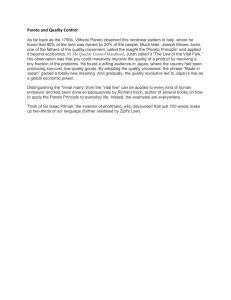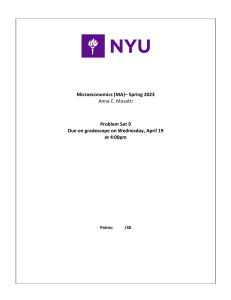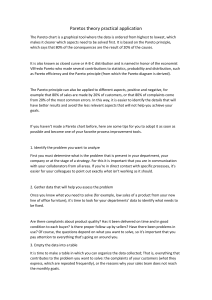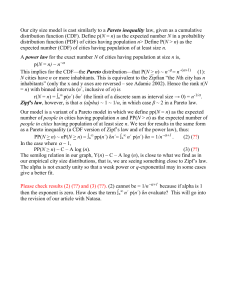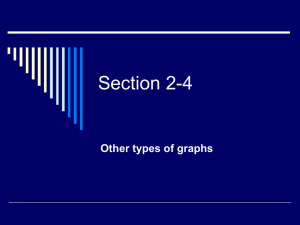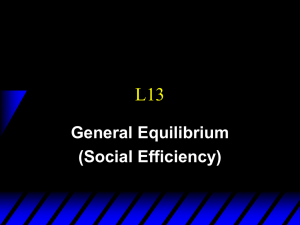80/20 Pareto's Principle in Project Management communication
advertisement
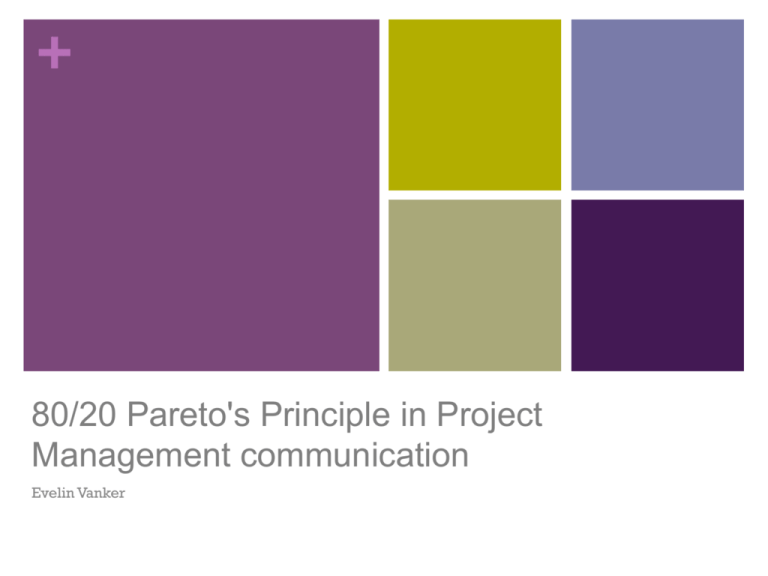
+ 80/20 Pareto's Principle in Project Management communication Evelin Vanker Table of content • Customer’s and project manager’s profiles in the baseline • Project variables • Reasons for successful project • 80/20 Pareto’s principle in communication • Communication channels • Creating communication strategy • Communication plan • Value of a communication plan • Conclusion + + Customer • Mostly knows how much money he has • Usually wants something, but not completely sure how much he can actually have for that money • His needs can change over the time, but the budget remains the same! • Knows when he wants the product to be delivered – on time! + Project Manager Has to keep everyone happy! Variables managing a project An effective project management methodology is required for managing: scope, time, resources (budget, human etc.), change, risk, issues, configuration, quality, and communication . TIME + QUALITY SCOPE MONEY + Management alternative! :) Pareto’s Principle The Pareto principle (also known as the 80–20 rule, the law of the vital few, and the principle of factor sparsity) states that, for many events, roughly 80% of the effects Vilfredo Pareto come from 20% of the causes. E.g. 80% of your sales come from 20% of your clients. Many businesses have an easy access to dramatic improvements in profitability by focusing on the most + Joseph M. Juran effective areas and eliminating, ignoring, automating, delegating or retraining the rest, as appropriate. What could be the 20% of the issues in communication that results in 80% of the outcomes? One possible option is poorly or very well planned and managed communication plan. + Reasons projects are successful n User/customer engagement n Executive Management Support n Clear Statement of Requirements n Clear Vision & Objectives n Proper Planning define the project carefully n Realistic Expectations n Smaller Project Milestones n ROI n Ownership n Hard-Working, Focused Staff Successful project managers typically have good communications skills that include being able to effectively present the issues, listen and act on feedback, and foster harmony among team members. Reference: http://www.enterprisecioforum.com/en/blogs/pearl/it-project-failure-symptoms-and-reasons Communication channels The key to successful communications is to keep information flowing in the right direction. Upward channel Lateral channel Downward channel Communicate to senior executives Communicate to clients, vendors and functional managers Provide direction to project team Highlight issues, risks and exceptions + Involves negotiations for resources, budgets and time allocations Highlight tasks pending, scheduled tasks, dates, and general team briefings Tools used: • Exception reports • Weekly status reports • Project charter • E-mail updates • Face-2-face reviews • Communication plan Tools used: • Communication plan • Statement of work • Contracts • E-mail Tools used: • Verbal exchanges • Agendas, minutes • E-mail • Project brief • Project plan • Issue logs Strengthens the buy-in from top Requires diplomacy and tact Requires delegation skills Reference: http://www.techrepublic.com/article/project-communications-a-plan-for-getting-your-message-across/1061894 Creating communication strategy Before drafting your communication plan, start with a brief analysis of what you hope to achieve. Begin with an overview of your program’s communications environment, objectives and goals. Include a short situation analysis where you look at your project’s communications strengths, weaknesses, opportunities and threats (SWOT-analysis). + • What? what you want to accomplish with your association communications (your objectives); ways in which those objectives can be accomplished (your goals or program of work • Who? The target of the communication (e.g. all stakeholders, PM, Project Team, and so on) • Why? The goals and objectives of the project communication process • When? The timing and frequency requirements for all formal and informal communication activities • How? The mechanisms and formats for the elements of the project communication process (tools and timetable); how you will measure the results of your program (evaluation) Reference: www.the-program-manager.com/project-management/why-projects-fail-part-two-the-matter-of-communication/ Developing a project plan The communication plan sets out a clear framework for your communication activities and allocates roles, tasks and goals to individual members of the team. It will serve you as a guiding document throughout the program’s lifecycle including information on objectives, audiences, messages, tools and budget available. + Information Communication Type Type Project Milestone or Responsible Frequency of Person Communication Project Phase Stakeholder(s) Storage Location e.g., All Associate VP Status Report Meeting/Paper Weekly Project Manager Project Folder e.g., Initiation Director Approval request Paper End of Initiation Process Project Leader Project Folder e.g., All Project Team All notes and documentation Electronic documents Length of Project Project Team Wiki Value of an effective communication plan • Facilitates team development: Proper communication actually provides the basis for the project team to work together and understand objectives and tasks to be completed. Better communication means better performance. • Helps stakeholders understand the project goals: From defining the user requirements to implementing the product, a proper communication plan aids in informing all project stakeholders what communication channels will be used on the project, who will report to whom, and the frequency, type, and format of project meetings. + • Makes it easier to update stakeholders • Reduces time of creating unnecessary documentation + Conclusion To plan and manage communication project manager should: • understand the (communication) expectations of different stakeholders. How much and what information do they need? • involve stakeholders in the process of developing the communication strategy and plan • understand the project environment, goals and objectives • analyze project’s communications strengths, weaknesses, opportunities and threats • know and understand the tools to be used in communication • understand the value of the communication plan • not over communicate (too much information could be crucial to the outcome)! + References: • Jason P. Charvat. Project communications: A plan for getting your message across http://www.techrepublic.com/article/project-communications-a-plan-for-gettingyour-message-across/1061894 • Saverio Losito. Why projects Why projects fail (part two) – the matter of communication. http://www.the-program-manager.com/project-management/why-projects-failpart-two-the-matter-of-communication/ • Pearl Zhu. IT project failure: symptoms and reasons. http://www.enterprisecioforum.com/en/blogs/pearl/it-project-failuresymptoms-and-reasons • Michele McDonough. Explaining Pareto's 80/20 Rule. http://www.brighthubpm.com/monitoring-projects/65152-explainingparetos-8020-rule/ • Benoit Hardy-Vallee. How to Run a Successful Project. http://businessjournal.gallup.com/content/152756/run-successfulproject.aspx#1 • Investopedia. http://www.investopedia.com/terms/i/interpersonal-skills.asp#axzz2N2FFm3i8 • Patrick Waddik. A Project Charter Communication Strategy Is Essential. http://www.isixsigma.com/implementation/change-managementimplementation/project-charter-communication-strategy-essential/ + THANK YOU!

